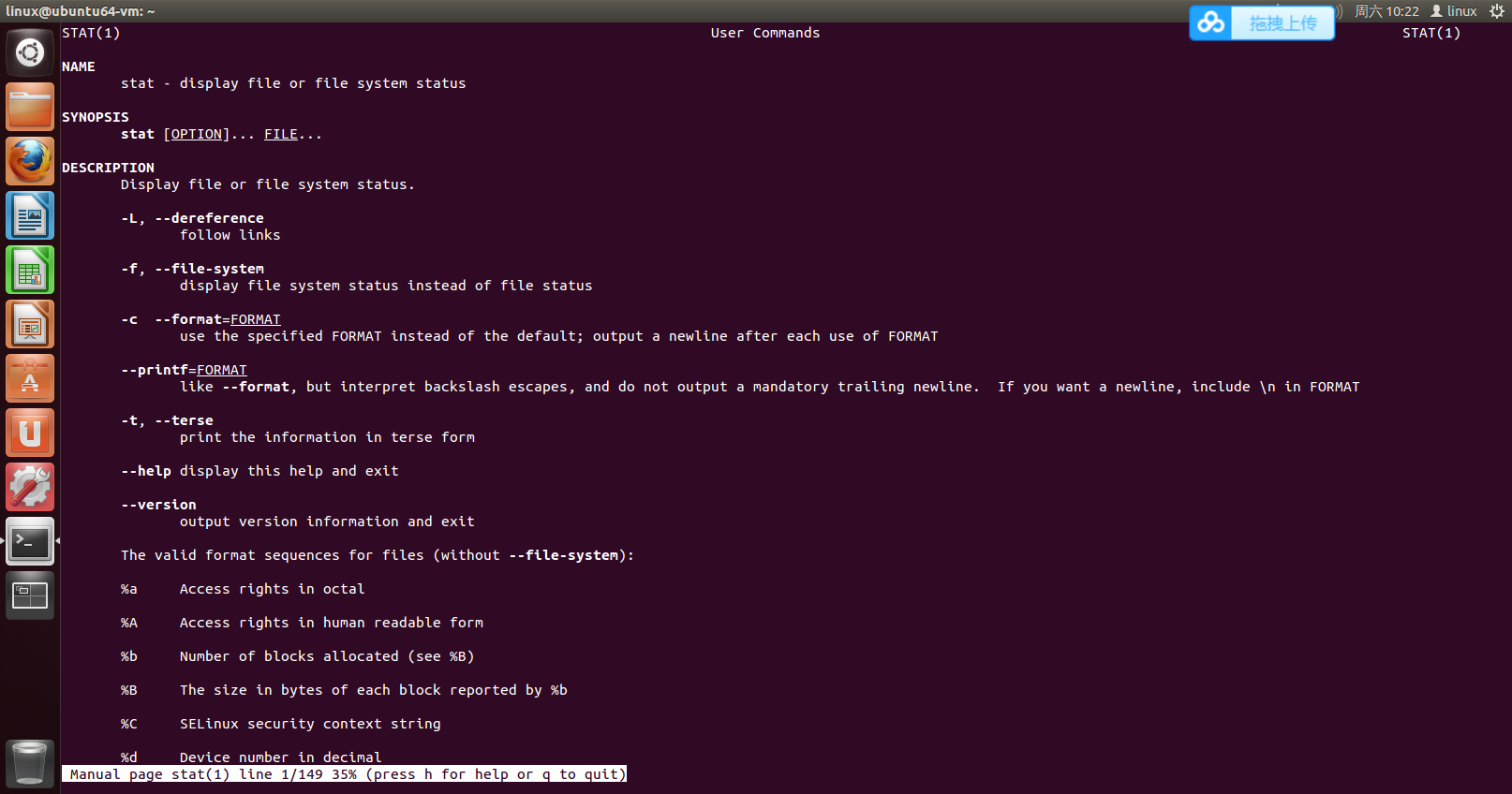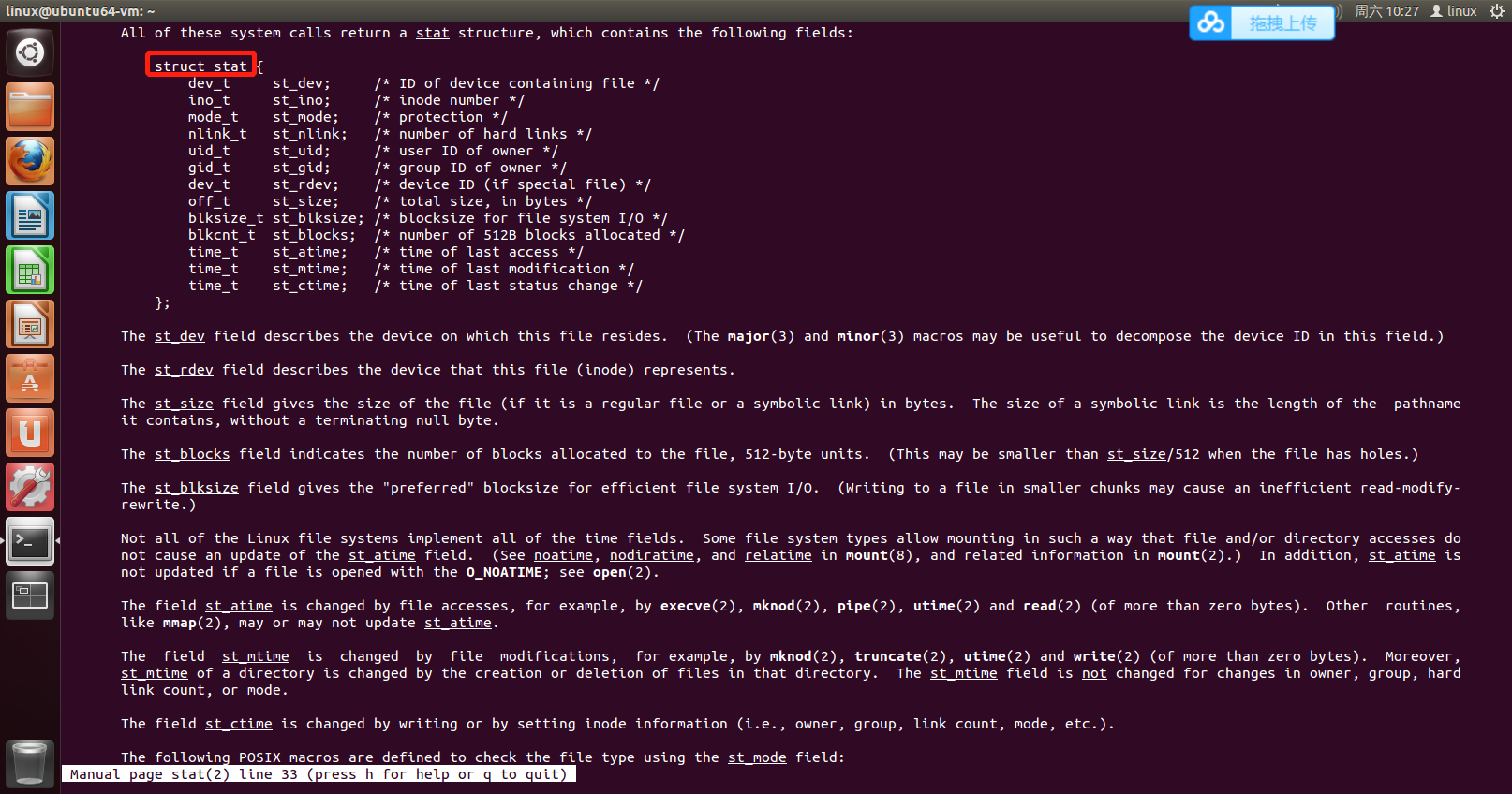一、题目要求
学习使用stat(1),并用C语言实现
- 提交学习stat(1)的截图
- man -k ,grep -r的使用
- 伪代码
- 产品代码 mystate.c,提交码云链接
- 测试代码,mystat 与stat(1)对比,提交截图
二、题目理解
Linux下stat的功能:在命令行输入man 1 stat进行查看:
- 命令格式:stat [选项]
- 命令功能:显示的是文件的I节点信息。Linux文件系统以块为单位存储信息,为了找到某一个文件所在存储空间的位置,用I节点对每个文件进行索引,I节点包含了描述文件所必要的全部信息,其中包含了文件的大小,类型,存取权限,文件的所有者。
- 常用参数:
- -f 不显示文件本身的信息,显示文件所在文件系统的信息。
- -L 显示符号链接。
- -t 只显示摘要信息。
发现see also里面推荐我们查看stat(2),所以在命令行输入man 2 stat进行查看:
Linux下的stat函数:int stat(const char *file_name, struct stat *buf );
- 函数功能:通过文件名filename获取文件信息,并保存在buf所指的结构体stat中
- 头文件:
#include <sys/stat.h>
#include <unistd.h>- stat结构体:
struct stat {
dev_t st_dev; //文件的设备编号
ino_t st_ino; //节点
mode_t st_mode; //文件的类型和存取的权限
nlink_t st_nlink; //连到该文件的硬连接数目,刚建立的文件值为1
uid_t st_uid; //用户ID
gid_t st_gid; //组ID
dev_t st_rdev; //(设备类型)若此文件为设备文件,则为其设备编号
off_t st_size; //文件字节数(文件大小)
unsigned long st_blksize; //块大小(文件系统的I/O 缓冲区大小)
unsigned long st_blocks; //块数
time_t st_atime; //最后一次访问时间
time_t st_mtime; //最后一次修改时间
time_t st_ctime; //最后一次改变时间(指属性)
};三、伪代码
- 指定文件名filename
- 定义stat结构体,调用stat()函数,将filename中的信息储存再stat结构体中
- 用原点标记符得到stat中的属性,并用printf将其输出
四、代码实现
#include <sys/types.h>
#include <sys/stat.h>
#include <time.h>
#include <stdio.h>
#include <stdlib.h>
int main(int argc, char *argv[])
{
struct stat sb;
if (argc != 2)
{
fprintf(stderr, "Usage: %s <pathname>\n", argv[0]);
exit(EXIT_FAILURE);
}
if (stat(argv[1],&sb) == -1)
{
perror("stat");
exit(EXIT_FAILURE);
}
printf("File type: ");
switch (sb.st_mode&S_IFMT)
{
case S_IFBLK:
printf("block device\n");
break;
case S_IFCHR:
printf("character device\n");
break;
case S_IFDIR:
printf("directory\n");
break;
case S_IFIFO:
printf("FIFO/pipe\n");
break;
case S_IFLNK:
printf("symlink\n");
break;
case S_IFREG:
printf("regular file\n");
break;
case S_IFSOCK:
printf("socket\n");
break;
default:
printf("unknown?\n");
break;
}
printf("文件: '%s'\n",argv[1]);
printf("大小: %lld ",(long long) sb.st_size);
printf("块: %lld ",(long long) sb.st_blocks);
printf("IO块: %ld\n",(long) sb.st_blksize);
printf("设备: %d ",sb.st_dev);//文件设备编号
printf("Inode: %d ",sb.st_ino);//文件i节点标号
printf("硬链接: %ld\n", (long) sb.st_nlink);
printf("权限: %lo (octal) ",(unsigned long) sb.st_mode);
printf("Uid=%ld Gid=%ld\n",(long) sb.st_uid, (long) sb.st_gid);
printf("最近更改: %s", ctime(&sb.st_ctime));
printf("最近访问: %s", ctime(&sb.st_atime));
printf("最近改动: %s", ctime(&sb.st_mtime));
printf("创建时间: -\n");
exit(EXIT_SUCCESS);
}




